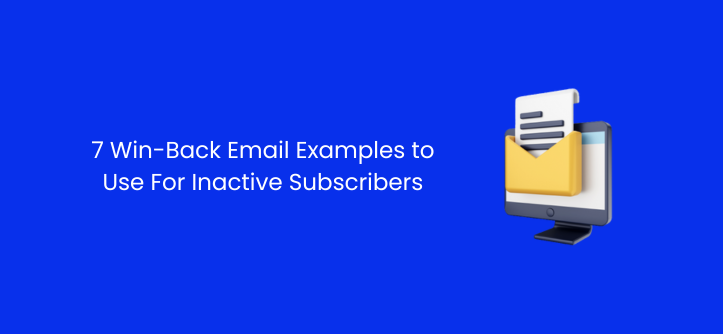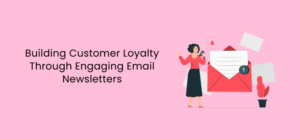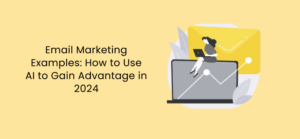A fiercely competitive market means that businesses must have strategic efforts that are targeted at reaching specific goals such as customer acquisition and retention, in order to stay relevant in today’s world.
Email marketing remains one of the most effective marketing strategies for growing your business and retaining customers. It provides a direct line of communication and accurate data on the performance of your marketing efforts. You can tell what’s working and revamp what isn’t easily.
Win-back emails are formulated to help you re-engage old email subscribers who may have fallen off the email conversions funnel. They’re crucial in increasing your customer retention scores and can serve as a way to re-ignite the bonds that once existed between you and your email subscribers.
In this article, we’ll show you why win-back emails are crucial and share examples for you to borrow from.
What Are Win-Back Emails?
They are simply emails that say “We want you back” and are usually sent off to your inactive subscribers. In order to build customer loyalty, your brand must stay top-of-mind through various touch points – sales, purchases, social media etc.
When customers fall off the sales funnel wagon, win-back emails can be used to re-engage them and win them over.
Why Are Win-Back Emails Necessary?
Customer retention – the ability of a business to retain its existing customers over a specific period – goes beyond one-off purchases and emphasizes building long-term relationships with clients.
As customer acquisition costs soar, companies focus more on nurturing existing relationships to keep customers coming back instead of investing so much in getting new ones all the time. One of the most effective tools in achieving this is email marketing.
It allows businesses to communicate with customers on a more personal level.
Email marketing is an excellent tool for nurturing leads and guiding potential customers through the sales funnel.
Types of Win-Back Emails to Send
We’re still here: These emails are friendly reminders to customers who haven’t visited your website or made a purchase in a while. They typically remind them about the benefits of your products or services and how they can still benefit from being part of your community.
We miss you – These emails contain personalized offers and special discounts that are targeted at getting the customers to make action.
Do you still want to hear from us: Some inactive subscribers are simply uninterested in hearing from you, while others may have simply gotten your emails lost in their inbox. If you have a re-engagement campaign, use an opt-in confirmation email to ensure that customers genuinely want to continue receiving your emails. This can help you clean up your email list and focus on engaged subscribers.
Last Chance: Unsubscribe emails are as important as any other. Giving your subscribers the option to unsubscribe to your email list is one that shouldn’t be joked around with. As a last attempt to win back customers, send a last-chance email informing them that you’ll be removing them from your mailing list if they don’t re-engage within a specific timeframe.
7 Win-Back Email Examples To Use For Re-engagement Campaigns
Follow-up Recommendations Based on Past Purchases
This win-back email is designed to engage with customers who have made purchases in the past but have been inactive for a while. This type of email suggests products or services based on the customer’s previous purchases, aiming to rekindle their interest and remind them of the value your brand can provide.
Show your knowledge of the customer’s preferences and offer personalized suggestions to encourage them to return to your website or store.
Here’s a sample you can tweak for your use:
Hey John,
It’s been a while since you’ve rocked those awesome kicks from Sneaker Spot, and we miss seeing you around! We’ve handpicked some fresh styles we think you’ll love.
Check out these personalized recommendations:
- Nike Air Max 270: Perfect for your active lifestyle, these kicks offer ultimate comfort and style.
- Adidas Ultraboost 21: Boost your performance with these top-of-the-line running shoes, a favorite among sneaker enthusiasts.
- Vans Old Skool: Classic and versatile, these sneakers add a touch of retro charm to any outfit.
As a special welcome-back treat, enjoy a 15% discount on any of the recommended pairs. Use code “WELCOME15” at checkout.
Reconnect with your sneaker game and get the latest updates and exclusive deals by resubscribing now:
[CTA Button: Re-subscribe Now]
If you have any questions or need assistance, our support team is here to help.
Thanks for being a part of the family. We can’t wait to see you rocking your new kicks!
Best regards,
‘Rate Our Service’ or ‘Give us Some Feedback’
The primary goal of this win-back email is to gather valuable feedback from customers who have not interacted with your brand in a while.
By reaching out and showing that you care about their opinions, you encourage them to re-engage with your business while also gaining insights into potential issues that may have caused their disengagement.
Below is a great example from Airbnb that underscores the importance of this email.
Remember to keep the email concise and visually appealing, making it easy for the recipient to understand the message and take the desired action. Also, personalization, such as using the customer’s name, adds a touch of warmth and shows that the email is tailored to their specific experience.
Offer an Irresistible Discount
Want to rekindle interest in your brand? Send a discount to an inactive customer. This email type offers a special and time-limited discount or promotion to create a sense of urgency and encourage the customer to take action and make a purchase.
Discounts and limited deals are effective in enticing customers to make a purchase.
They can attract inactive customers who might be interested in your products or services but need that extra push to make their first purchase.
For instance, you can say –
“For a limited time, you can enjoy a fantastic 30% discount on your next purchase as our way of saying thank you for being a loyal customer. Don’t let this opportunity slip away!”
– as a way of getting your inactive customers to take advantage of a special discount.
Products Updates & New Releases
The win-back email strategy of sending information about product updates & new releases is an effective way to re-engage inactive or lapsed customers by informing them about recent developments in your product or service offerings.
These emails aim to capture the attention of previous customers who might have lost interest or stopped engaging with your brand.
For such emails, be sure to use an attention-grabbing and compelling subject line. Clearly highlight the new features, improvements, or enhancements you’ve made to your product or service in the email body.
Focus on how these updates address pain points or add value to the customer’s experience and incorporate images, videos, or GIFs to showcase the new features or product updates effectively.
Here’s a sample from Grammarly.
Surveys & Questionnaires About the Brand
This email is a type of re-engagement strategy aimed at understanding the reasons behind customer inactivity and gathering feedback to improve the overall customer experience.
This type of email involves sending a survey or questionnaire to inactive or lapsed customers, asking for their opinions and insights about the brand, products, services, or any other relevant aspect.
The survey data provides valuable insights into customer preferences, pain points, and expectations. You can understand what drives their purchasing decisions, what they like or dislike about your products or services, and what improvements they would like to see.
It also helps you identify areas for improvement in your products or services. You can use the data to make necessary adjustments, add new features, or refine existing offerings based on customer feedback.
Here’s a sample you can adopt:
Subject Line: We Miss You! Share Your Thoughts for a Reward.
Dear [Customer’s Name],
We’ve missed you! Your opinion matters, and we want to improve.
Take our short survey and get a [X%] discount on your next purchase. Plus, enter a giveaway to win [Prize]!
[CTA Button: Take the Survey Now]
Your feedback is anonymous and will help us serve you better.
Unsubscribe anytime, but we hope to see you back soon!
Thank you.
Seasonal Offers
The ‘Christmas cheer’, ‘Black Friday rush’ or the ‘spirit of the new year’ are all great moments to recapture inactive customers with seasonal campaigns. Seasonal offers in win-back emails leverage specific occasions, holidays, or events to re-engage inactive customers.
With this email content tied to a relevant seasonal theme, businesses can capture the attention of lapsed customers who might have been disengaged for an extended period.
These emails often include exclusive promotions, discounts, or limited-time offers, encouraging recipients to take advantage of the seasonal appeal and make a purchase.
Check out this great sample from Premio sent to customers for Black Friday.
Final Thoughts
Creating and sending out win-back emails is just the first step in your engagement strategy.
Once the re-engagement emails have been sent, monitor key metrics such as open rates, click-through rates, and conversion rates to gauge the effectiveness of the campaign. A/B testing can also be employed to iterate and improve email content and design. To make things easier, use email automation tools and drip campaigns to streamline the entire process.
In the end, you should have built a list of engaged subscribers and leads that you can use to grow your business.




